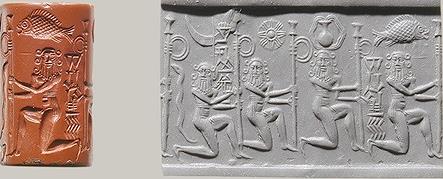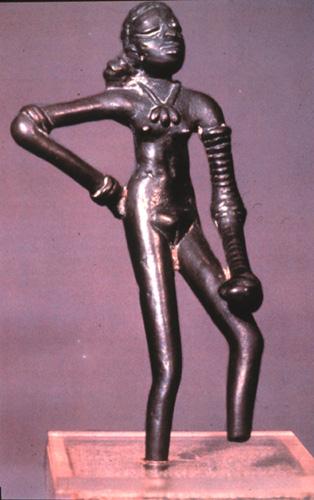Mirror: http://tinyurl.com/qe9yu4l
Indus Script hieroglyph-multiplexes on the statue are linguistic-lexis determinatives of the Meluhha -- vāk -- speech [mentioned as mleccha vācas distinguished from (chandas) literary form ārya vācas mentioned in Manu Samhita 10.45].
The lexis is a set of messages of blacksmith's metal implements out of smithy-forge and constitute a display, a celebration of metallurgical competence of the artisans. The statue is a bronze casting using cire perdue (lost-wax) casting technology.
A characteristic feature of the Indus Script is that within a very small space of an artefact messages of metalwork are communicated unambiguously and with extraordinary diligence, care and precision. For instance, many miniature tablets of Harappa are just the size of a thumbnail, many of which can be seen in the exhibits of Madras Egmore Museum. The dancing girl bronze statue is just 10.5 cm. tall, but studded with many hieroglyph-multiplexes of catalogus catalogorum of metalwork. Hieroglyphs are signified not merely on potsherds, seals, tablets, metal implem ents but also on artefacts in the round. The artisans engraved with care and diligence, very precise messages broadcasting their metallurgical competence. This may also explain the procession-scenes on some tablets and on Ancient Near East cylinder seals or Warka vase.

Red jasper H. 1 1/8 in. (2.8 cm), Diam. 5/8 in. (1.6 cm) cylinder Seal with four hieroglyphs and four kneeling persons (with six curls on their hair) holding flagposts, c. 2220-2159 B.C.E., Akkadian (Metropolitan Museum of Art) Cylinder Seal (with modern impression). The four hieroglyphs are: from l. to r. 1. crucible PLUS storage pot of ingots, 2. sun, 3. narrow-necked pot with overflowing water, 4. fish A hooded snake is on the edge of the composition. (The dark red color of jasper reinforces the semantics: eruvai 'dark red, copper' Hieroglyph: eruvai 'reed'; see four reedposts held).
Display of a dance-step in an exquisite bronze statue 10.5 cm. high
Place of Origin: Mohenjodaro Materials: Bronze Dimensions: 10.5 x 5 x 2.5 cm. Acc. No. 5721/195 National Museum. New Delhi ca. 2500 BCE
I am grateful to Prof. TP Verma for pointing out something which has so far been unnoticed by all archaeologists and art critics. The reference is to an object held in the left hand and resting on her left knee of this dancing girl statue. In Prof. Verma's view, this is NOT a begging bowl of a dancer but a representation of Parvati as Annapurna, noting that the most striking feature of Harappan figures is that Mother goddesses are shown naked. Thus nudity is the sign of divinity.
I suggest that the object held in her hand is a deepam, diya, lamp. It is possible that the lamp held on her hand was used with a wick and oil to light up like a lamp as a demonstration piece, an exhibit of the metallurgical competence of the artisans of Mohenjo-daro.
There is another bronze of Mohenjodaro showing a lady holding perhaps a deepam comparable to pāvai-viḷakku bronzes in South Indian tradition.
 Mohenjo-daro. Bronze Statue. Lady holding a deepam. Bronze statue of a woman holding a small bowl, Mohenjodaro; copper alloy made using cire perdue method (DK 12728; Mackay 1938: 274, Pl. LXXIII, 9-11)
Mohenjo-daro. Bronze Statue. Lady holding a deepam. Bronze statue of a woman holding a small bowl, Mohenjodaro; copper alloy made using cire perdue method (DK 12728; Mackay 1938: 274, Pl. LXXIII, 9-11)பாவைவிளக்கு pāvai-viḷakku, n. < id. +. Lamp with a damsel-shaped stand; பிரதிமை விளக்கு. பொலம்பாலிகைகளும் பாவைவிளக்கும் பல வுடன் பரப்புமின் (மணி. 1, 45).
The dancing girl statue is shown wearing wristlets and bangles on her arms.
Hieroglyph: karã̄ n. pl. ʻwristlets, bangles ʼ(Gujarati)(CDIAL 2779) Rebus: khār खार् 'blacksmith' (Kashmiri) khār 1
Hieroglyph: várti
Thus karã̄ 'hands with wristlets and bangles' PLUS baṭi 'lamp' Rebus: khāra-bhāṭi 'blacksmith's smelter'.
Hieroglyph: Ta. koṇtai tuft, dressing of hair in large coil on the head, crest of a bird, head (as of a nail), knob (as of a cane), round top. Ma. koṇṭa tuft of hair. Ko. goṇḍ knob on end of walking-stick, head of pin; koṇḍ knot of hair at back of head. To. kwïḍy Badaga woman's knot of hair at back of head (< Badaga koṇḍe). Ka. koṇḍe, goṇḍe tuft, tassel, cluster. Koḍ. koṇḍe tassels of sash, knob-like foot of cane-stem. Tu. goṇḍè topknot, tassel, cluster. Te. koṇḍe, (K. also) koṇḍi knot of hair on the crown of the head. cf. 2049 Ta. koṭi. / cf. Skt. kuṇḍa- clump (e.g. darbha-kuṇḍa-), Pkt. (DNM) goṇḍī- = mañjarī-; Turner, CDIAL, no. 3266; cf. also Mar. gōḍā cluster, tuft.(DEDR 2081) Rebus: kõdār ’turner’ (Bengali); kõdā ‘to turn in a lathe’ (Bengali).कोंद
kōnda ‘engraver, lapidary setting or infixing gems’ (Marathi)
What is shown as a hypertext on a potsherd is also shown on the Mohenjo-daro bronze figurine of a dancer's dance-step. The gloss is meḍ 'dance' (Remo); meṭṭu dance step (Telugu) Rebus: mẽṛhẽt, meḍ 'iron' (Mu.Ho.)
 Santali glosses.
Santali glosses.Hieroglyph: S. P. kaṇḍhī f.; kaṇṭhaka m. ʻ necklace ʼ Kathās., °ṭhikā -- f. lex. [kaṇṭhá -- ]Pk. kaṁṭhiā -- f., B. kã̄ṭhī, °ṭī ʻ ring round the neck (of bird, snake &c.) ʼ; Or. kaṇṭhā ʻ necklace ʼ, °ṭhi ʻ one -- stringed necklace, horse's halter ʼ; H. kaṇṭhā m. ʻ gold necklace ʼ (→ P. kaṇṭhā m., S. kaṇṭho m. ʻ necklace ʼ), kaṇṭhī f. ʻ small do. ʼ, poet. kã̄ṭhā m. ʻ red and blue ring round a parrot's throat ʼ; OM. kāṁṭhā m. ʻ necklace ʼ. -- Ext. with -- ll -- : S. kaṇḍhilo m. ʻ a kind of necklace for children ʼ; P. kaṇḍhlī f. ʻ necklace ʼ; H. kaṇṭhlā, kaṭh° m. ʻ gold or silver necklace worn as an amulet against evil ʼ.Addenda: kaṇṭhaka -- : WPah.kṭg. kaṇḍhi f. ʻ hairy ring on neck of some birds ʼ.(CDIAL 2681) Rebus: khaNDa 'implements'.
Pendants, 'bulbous shaped': kanda m. ʻ bulbous root ʼ MBh., n. ʻ garlic ʼ lex. [Prob. with gaṇḍa -- 1 ← Drav. T. Burrow BSOAS xii 369 and EWA i 152 with lit.]Pa. kanda -- m. ʻ bulb, bulbous root ʼ; Pk. kaṁda -- m. ʻ bulbous root ʼ, °dī -- f. ʻ radish ʼ; Or. kandā ʻ edible bulbous root; OMth. kã̄da ʻ bulb ʼ; H. kã̄dā m. ʻ onion, Allium capa ʼ, kandā ʻ squill, Scilla indica ʼ; G. kã̄dɔ m. ʻ bulbous root, onion ʼ, M. kã̄dā m.; Ko. kã̄ndo m. ʻ onion ʼ.(CDIAL 2723) Rebus: khaNDa 'implements'.
kolom 'three' Rebus: kolimi 'smithy, forge'. Thus the three pendants on the necklace worn on the statue signify: metal implements from smithy,forge.
Similar hieroglyph multiplexes on figurines and cylinder seal hieroglyphs of Ancient Near East also constitute metalwork catalogues of Meluhha smths.

 Why is a 'dancing girl' glyph shown on a potsherd discovered at Bhirrana? Because, dance-step is a hieroglyph written as hypertext cipher: meḍ 'dance' (Remo); meṭṭu dance step (Telugu) Rebus: mẽṛhẽt, meḍ 'iron' (Mu.Ho.)
Why is a 'dancing girl' glyph shown on a potsherd discovered at Bhirrana? Because, dance-step is a hieroglyph written as hypertext cipher: meḍ 'dance' (Remo); meṭṭu dance step (Telugu) Rebus: mẽṛhẽt, meḍ 'iron' (Mu.Ho.)S. Kalyanaraman
Sarasvati Research Center
September 27, 2015


